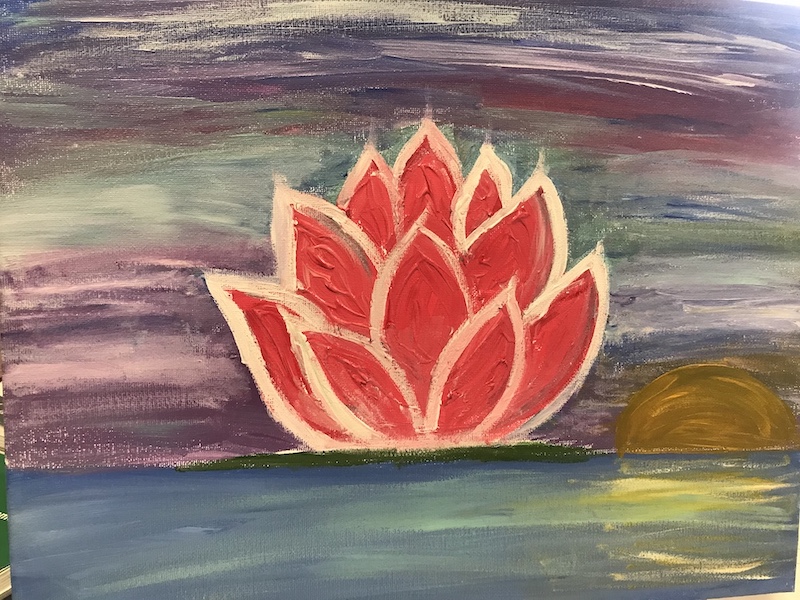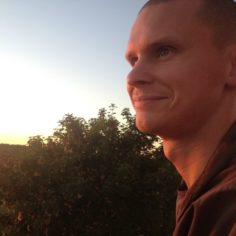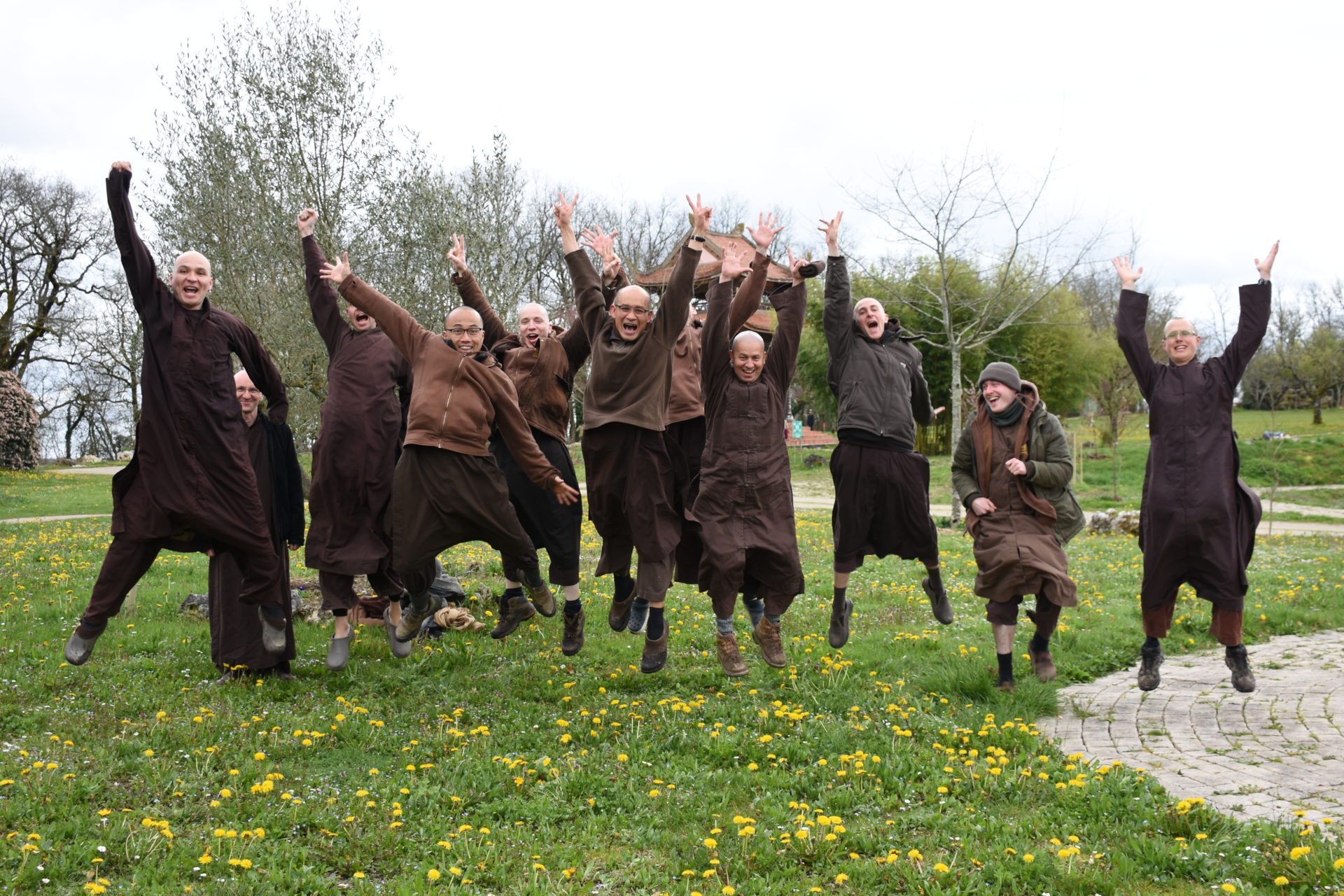
Ever since I can remember, I have been driven. There was urgency in how I rode a bicycle, how I needed to be first in finishing an exam in school, how I made more money than others, and how I started to work at sixteen years old. At age nineteen, I drove a company car. At twenty-two I bought my house, and at twenty-six I had my own company and a six-figure salary.

Ever since I can remember, I have been driven. There was urgency in how I rode a bicycle, how I needed to be first in finishing an exam in school, how I made more money than others, and how I started to work at sixteen years old. At age nineteen, I drove a company car. At twenty-two I bought my house, and at twenty-six I had my own company and a six-figure salary.
It was no surprise that at age twenty-seven, after ten years of working, I had my first burnout. This was also the time I first found Plum Village. Now my strong volition was applied to the spiritual dimension. After hearing about the Five Mindfulness Trainings, I sold my car and house. I took the trainings twelve hours later. Then I bought a hut, started Wake Up Sanghas, organised retreats, and finally became a monk when I realised that nobody wanted to create a Plum Village and Wake Up community with a fanatic like myself.
Of course, now without irony, I also see that I had a deep wish to connect. I felt a deep sense of loneliness and intuitively knew that to be free and happy, I needed to learn to enjoy my own company. After eight years as a monk, I am starting to see some fruits. I now can enjoy drinking a cup of tea.
The reason why I suffered, why I needed to run, why I was so driven, was because I was unable to feel emotions and how they manifest in my body.
In my journey, I’ve found that words often are very limiting. Yet in poetry, sometimes I can say more, because I can say the unsaid and fulfil my wish to express myself.
Our raging afflictions
An intense dangerous fire
The heat ready to burn
If you believe it will
The imagined radiance
The nature of a dream
Only our fear towards it
Creates the threat
For how long have I been fooled
Imprisoned and enslaved in the realms of suffering and darkness
Just, just, because
In the believing it was real
I made it so
Writing in my diary is also a way I explore and express my feelings. Last summer, I wrote:
I am a stressed out, burntout, traumatised monk, and I am happy. I found in my burning afflictions the very colours that paint beauty in life. By daring to step into the unpleasant life-threatening feelings and body sensations, I discovered that my beliefs about myself are not true. Not only are they not true; the very nature of this suffering is empty of sustenance. I only believe them into existence, and the threat of their existence is the confirmation of the belief.
I have been running all my life, fuelled by strong feelings that I could not yet feel consciously. These feelings let me know that if I felt them, I would die. Maybe this is the deeper meaning of the First Noble Truth: stop running, start suffering, and experience the truth that I do not die when I feel those feelings. The strong feelings may give the illusion that I will die, but I don’t. So now when I feel life-threatening feelings, I actively feel them. I no longer have to be afraid of them. I no longer have to live a life of reactivity because of a feeling. I no longer have to put the blame on conditions outside of myself that give rise to a feeling. When I allow feelings to express themselves, they heal, and transformation happens at the base.
I now understand that these life-threatening feelings are related to traumatic experiences I had. I’ve learned that trauma happens when I experience an intense emotional feeling that I cannot handle. The nervous system overloads, and a memory gets stored in disconnected fragments, in the body, in the feelings, in the story. Normally a memory has these components and they are connected. Then, when a similar situation occurs, the memory gets triggered but only partly, so only the body will respond. In my case, my body responds with a burning sensation in my chest, but without any emotional feeling or story. I feel that something is wrong, there is a threat somewhere, but I cannot locate it. My mind uses the current situation to explain why I am feeling this way. This means, for example, I might think, “My elder brother is dangerous. He will try to manipulate me; he is not to be trusted; he is scheming behind my back; he is the reason I do not feel safe.”
I can get caught in the illusion that my emotions follow the interpretation of the present moment. I can believe sense contact leads to perception, which leads to feelings. Following this reasoning, if I change my perception, I can change the feeling, which implies that analysing the content of my mind and getting insight about the working of my mind leads to transformation of suffering. I then put a lot of emphasis on asking, “Why is the content of my mind like this?” and thinking that an answer will lead to the end of suffering. But it doesn’t lead to the end of suffering because sense contact leads to feeling, which conditions my perception. In neuroscience, sense contact is the primacy of emotions. We are emotional beings, not rational beings.
This leads to the question: what is an emotion? In the book How Emotions Are Made: The Secret Life of the Brain, Lisa Feldman Barrett writes that sense contact leads to a response in the body, which leads to a perception of these sensations called interoception. I believe the Buddha uses the word feelings for this. This interoception then uses the context of the situation to create an emotion. The same interoception of an intense sensation in the stomach can be interpreted as anxiety in a dentist’s waiting room and as joyful anticipation on a wedding day. So an emotion has a body part, a feeling part, and a context/story part. An emotion is not just the peak experience, like raging anger, despair, etc., but it is always there and has a rich life, which can be subtle and intense. I can touch my suffering at any moment, but I can only experience this in the body. I believe most of us are almost completely disassociated from our bodies because the only way not to feel dreadful feelings is to ignore where they live in the body. Even if I do not actively ignore those feelings, I may say that I do not feel those feelings right now, and that what I do not feel is not there.

This brings me to how perception works. In neuroscience, a popular theory is called predictive coding. It explains how the mind is one of the senses. Let me illustrate by sharing a story.
One day I was sitting in the car, and far away I saw something lying on the road. “Oh, no, a dead dog,” I thought. As I drove closer, I saw that it was a cardboard box. I might think that I always saw a cardboard box and that I just interpreted it as a dog until I saw it more clearly. I might think that I process all of my sense information and build my reality from that, and that I’m always in direct contact with reality. But this is not true. Science has proven that if this were true, the brain would be too slow to respond to the world. A baseball player would not be able to hit a ball if he relied on processing his sight in order to hit the ball. The tiger would have already jumped on us.
Instead, how I create reality is by predicting what will happen in the next moment based on my experience of the past. The brain only has to predict what will change. If there is a conflict between the past and the present, the brain checks with the senses—and then if the conflict is important enough, the brain updates its prediction. This explains why I can wake up in a dream and am unable to tell the difference between waking reality and dreaming reality. My reality is of the nature of a dream limited by sense information. So the main sense of sight is the mind. If I know how trees look, I might need only a little bit of sight information to see a tree in the mind. Predicting is much more energy efficient and quicker than processing the senses.
So did I see a dead dog on the road? Yes, I saw a dead dog— until my senses contradicted my mind’s prediction enough, which led to a strange feeling. Suddenly, I saw a cardboard box and the mind tried to tell me I had always seen only a cardboard box.
This brings me to the body and feelings. The mind is perfectly capable of predicting the body’s sensations. I realised that most of the time when I follow my breath, I follow my “dream breath.” Of course, it does not feel very interesting because I am predicting the breath. I already know the breath, so it’s as if I’m touching something dead, something not real. But when I start to pay attention and deeply focus on the breath, I can feel that the breath is a whole world with constant changing sensations, completely unknown, completely fascinating, a complete wonder.
This also brings me close to something that I do not want to feel: my suffering. I could practice a whole lifetime with only the mind and the dream body, so I wouldn’t have to touch my suffering. The moment I get in touch with the body as it is, I also get in touch with the suffering that is stored there, conditioning my feelings and perceptions in every moment. No longer can I predict away my body feelings. No longer can I ignore what is there—and that is freakily scary. But does it kill me? Even though it feels like I will die if I feel these feelings in the body, I can dip into them and start feeling them.
Part of the defense mechanism is that I define the suffering in my body as “not me,” not self but something outside of the self, an unwelcome intruder. But when I start to deeply feel my present feelings of suffering, I find my past suffering in them. I find my five-year-old self, my nine-year-old self. Memories come up. Intense feelings come up. Belatedly, I can allow them to express, and I can process them. I realize my suffering is me. Because now I allow myself to feel the suffering; I get access to my body and a wealth of feelings.
I realised I always have felt a bit dead, as if a bit of me was missing. I have found that bit now. I am no longer scared of it, as it is me and needs all my love.
I realised that burnout is about having multiple feelings that are in conflict with each other and that demand to be felt and no longer ignored. These feelings overwhelm the whole body, and when this happens, I need to start to listen. It is a wake-up call.
So how did I heal my suffering, my past trauma, and my burnout? By just being lazy, by allowing myself to heal—just like a hurt animal that lies down under a bush and rests. Last summer, I took a few weeks away and did not take any distractions with me. I drank tea and sat and walked and allowed myself to be fully bored, and always looked for feelings I did not want to feel and then felt them. I looked for sensations in the body and deeply concentrated on them, becoming the senses. I aimlessly dwelled in the senses and experienced whatever was there without trying to solve, without trying to interpret, without trying to push away or pull towards, just drinking a cup of tea. Just being.
The Way Out Is In
The Dharmakaya is the body itself
Radiating mindfulness, feelings, sensations, and all objects of mind
In this splendid manifestation mind is formed
What a foolishness then to bring the mind to the body
Or the Dharmakaya itself
You go in the wrong direction
Don’t you see
You already come from there
You are already there
You are already home
The Body
To go deeply in the body
You need a still mind
To have a still mind
You need to go deeply into the body
Seek when the mind is agitated where the body is not available
By including the unfelt sensations the mind calms
By resting in the felt body sensations
The unfelt body sensations appear
Resting between the felt and unfelt sensations they connect
And full body awareness arises
The mind revels in dwelling in unison with the body
Arriving home


